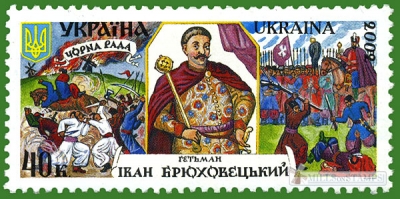-
Hetmans of Ukraine
Ukraine 2002.01.17
In issue: Stamp(s): 3
Printing: on fluorescent paper
Issued in: stamps of 35 stamps (5x7)
-
Number by catalogue: Michel: 484 Yvert: 438 Scott: 451
Perforation type: 12 ¼x12
Subject:
40 kopiyoks. Portrait of Hetman* Ivan Brjuhovetsky**. Battle scenes. At the left on a background two windmills
Additional:
*Hetman was the title of the second highest military commander (after the monarch) used in 15th to 18th century Poland, Ukraine and Grand Duchy of Lithuania, known from 1569 to 1795 as the Rzecz Pospolita.
This title was used among the Cossacks (гетьман) of Ukraine since the 16th century and by the Czechs (hejtman) in Bohemia from the Hussite Wars (15th century) onward.
**Ivan Brjuhovetsky (Ukrainian: Іван Брюховецький) (1623-1668) was a pro-Russian hetman of Left-Bank Ukraine.
He was a registered Cossack, belonging to the Chyhyryn Company. Early in his career he served as Bohdan Khmelnytsky's courier and diplomatic emissary. He was elected Kosh otaman (1661–3) of the Zaporozhian Sich, and in 1633 he succeeded Ivan Vyhovsky as Hetman of Ukraine, with the support of Moscow.
However Briukhovetsky reign and cruelty worked against him, early on he arrested and executed his opponents namely polkovnyks Samko and Vasili Zolotarenko, for support he signed the Moscow Articles of 1665, which placed Left Bank Ukraine under direct control of the Tsar. In return, Briukhovetsky acquired the title of Boyar, properties, marriage to Prince Dolgoruky's daughter. This treaty went on to be called the "Briukhovetsky treaty" and caused massive rebellion in Ukraine. His popularity among the Clergy fell when he suggested that Moscow to appoint and send a metropolitan to the Kievan Metropolia.
As his domestic policies failed Briukhovetsky put the blame on the Russian authorities and with the Cossacks rebelled in an attempt to save his reputation, but it was too late. Faced with his failures as hetman, in 1668 in the town of Budyshchi, a cossack mob killed him by chaining him to a cannon and beating him to death.Topics: Mills within the landscapes Windmills



